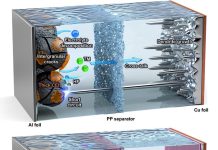
A new battery breakthrough from researchers at the University of Adelaide may change how we store energy for the future.
The team has developed a new version of the zinc–iodine battery that could offer more than double the performance of today’s lithium-ion batteries—and at a lower cost.
Led by Professor Shizhang Qiao from the University’s School of Chemical Engineering, the team created a new kind of electrode for zinc–iodine batteries.
Unlike the usual method that mixes iodine with liquids, this new process uses dry powders rolled into thick, solid electrodes.
A small amount of a chemical called 1,3,5-trioxane was also added to the battery’s electrolyte.
During charging, this chemical forms a flexible, protective layer on the surface of the zinc inside the battery.
That protective film is key. It prevents tiny, sharp structures—called dendrites—from growing on the zinc.
These dendrites can pierce through the battery and cause it to short-circuit. By stopping this problem, the new design helps the battery last much longer and work more safely.
Zinc–iodine batteries are already known for being safe, affordable, and better for the environment than lithium-ion batteries.
But until now, they haven’t performed as well. This new design changes that. The team managed to pack more than 100 milligrams of active material into each square centimeter of the battery—setting a new record.
They also showed that their pouch batteries kept 88.6% of their capacity after 750 charge cycles, and smaller coin-shaped versions retained nearly 99.8% after 500 cycles.
Dr. Han Wu, a researcher on the project, explained that this was possible because of the new dry electrode and the protective zinc layer.
Using advanced imaging techniques, the team was able to watch the protective film form in real time.
What makes this development so promising is that it could pave the way for cheaper, longer-lasting batteries to store renewable energy from wind and solar power. The dry electrodes don’t leak iodine like older designs do, and they’re more stable overall.
The researchers believe this could be a game-changer for large energy systems like power grids and remote microgrids.
The team now plans to further develop the technology. Professor Qiao says they are working on ways to scale up the battery production using reel-to-reel manufacturing.
By using lighter materials and cutting down on excess liquid inside the battery, they believe they can double the battery’s energy storage from 45 to around 90 watt-hours per kilogram. They also hope to apply their dry electrode method to other battery types, including ones using bromine.
This exciting advancement brings us one step closer to safer, more affordable energy storage for a greener future.
Source: University of Adelaide.



